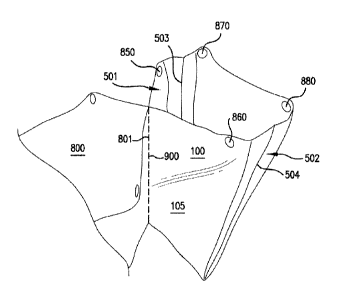Une partie des informations de ce site Web a été fournie par des sources externes. Le gouvernement du Canada n'assume aucune responsabilité concernant la précision, l'actualité ou la fiabilité des informations fournies par les sources externes. Les utilisateurs qui désirent employer cette information devraient consulter directement la source des informations. Le contenu fourni par les sources externes n'est pas assujetti aux exigences sur les langues officielles, la protection des renseignements personnels et l'accessibilité.
L'apparition de différences dans le texte et l'image des Revendications et de l'Abrégé dépend du moment auquel le document est publié. Les textes des Revendications et de l'Abrégé sont affichés :
| (12) Brevet: | (11) CA 2917641 |
|---|---|
| (54) Titre français: | SACS PERFORES |
| (54) Titre anglais: | PERFORATED BAGS |
| Statut: | Octroyé |
| (51) Classification internationale des brevets (CIB): |
|
|---|---|
| (72) Inventeurs : |
|
| (73) Titulaires : |
|
| (71) Demandeurs : |
|
| (74) Agent: | AIRD & MCBURNEY LP |
| (74) Co-agent: | |
| (45) Délivré: | 2016-05-03 |
| (86) Date de dépôt PCT: | 2014-07-23 |
| (87) Mise à la disponibilité du public: | 2015-02-19 |
| Requête d'examen: | 2016-01-06 |
| Licence disponible: | S.O. |
| (25) Langue des documents déposés: | Anglais |
| Traité de coopération en matière de brevets (PCT): | Oui |
|---|---|
| (86) Numéro de la demande PCT: | PCT/US2014/047825 |
| (87) Numéro de publication internationale PCT: | WO2015/023408 |
| (85) Entrée nationale: | 2016-01-06 |
| (30) Données de priorité de la demande: | ||||||
|---|---|---|---|---|---|---|
|
L'invention concerne une série de sacs présentant des perforations sur les panneaux avant et arrière qui relient la partie arrière d'un premier sac à la partie avant d'un second sac. Les sacs sont alignés et présentent des trous qui sont conçus pour être reçus par un socle pour supporter les sacs. Les sacs sont conditionnés et prêts à être chargés dans une position prête à l'emploi. Lorsque les sacs sont séparés les uns des autres, le sac suivant de la série continue s'alignera et s'étendra pour s'ouvrir dans une position d'utilisation. Les sacs peuvent être empilés les uns sur les autres dans une position prête à l'emploi.
The invention features a series of bags having perforations on the front and back panels that connect the back portion of one bag with the front portion of a second bag. The bags are aligned and features holes that are adapted to be received by a stand to support the bags. The bags are packaged and ready to load in a ready to use position. When the bags are separated from each other, the next bag m the continuous series will align and expand to open into a use position. The bags can be stacked on top of each other in a ready to use position.
Note : Les revendications sont présentées dans la langue officielle dans laquelle elles ont été soumises.
Note : Les descriptions sont présentées dans la langue officielle dans laquelle elles ont été soumises.

Pour une meilleure compréhension de l'état de la demande ou brevet qui figure sur cette page, la rubrique Mise en garde , et les descriptions de Brevet , États administratifs , Taxes périodiques et Historique des paiements devraient être consultées.
| Titre | Date |
|---|---|
| Date de délivrance prévu | 2016-05-03 |
| (86) Date de dépôt PCT | 2014-07-23 |
| (87) Date de publication PCT | 2015-02-19 |
| (85) Entrée nationale | 2016-01-06 |
| Requête d'examen | 2016-01-06 |
| (45) Délivré | 2016-05-03 |
Il n'y a pas d'historique d'abandonnement
Dernier paiement au montant de 125,00 $ a été reçu le 2023-11-10
Montants des taxes pour le maintien en état à venir
| Description | Date | Montant |
|---|---|---|
| Prochain paiement si taxe applicable aux petites entités | 2025-07-23 | 125,00 $ |
| Prochain paiement si taxe générale | 2025-07-23 | 347,00 $ |
Avis : Si le paiement en totalité n'a pas été reçu au plus tard à la date indiquée, une taxe supplémentaire peut être imposée, soit une des taxes suivantes :
Les taxes sur les brevets sont ajustées au 1er janvier de chaque année. Les montants ci-dessus sont les montants actuels s'ils sont reçus au plus tard le 31 décembre de l'année en cours.
Veuillez vous référer à la page web des
taxes sur les brevets
de l'OPIC pour voir tous les montants actuels des taxes.
Les titulaires actuels et antérieures au dossier sont affichés en ordre alphabétique.
| Titulaires actuels au dossier |
|---|
| RDC SYSTEMS, LLC |
| Titulaires antérieures au dossier |
|---|
| CASTRO, DEJA S. |
| RDC SYSTEMS, LLC |